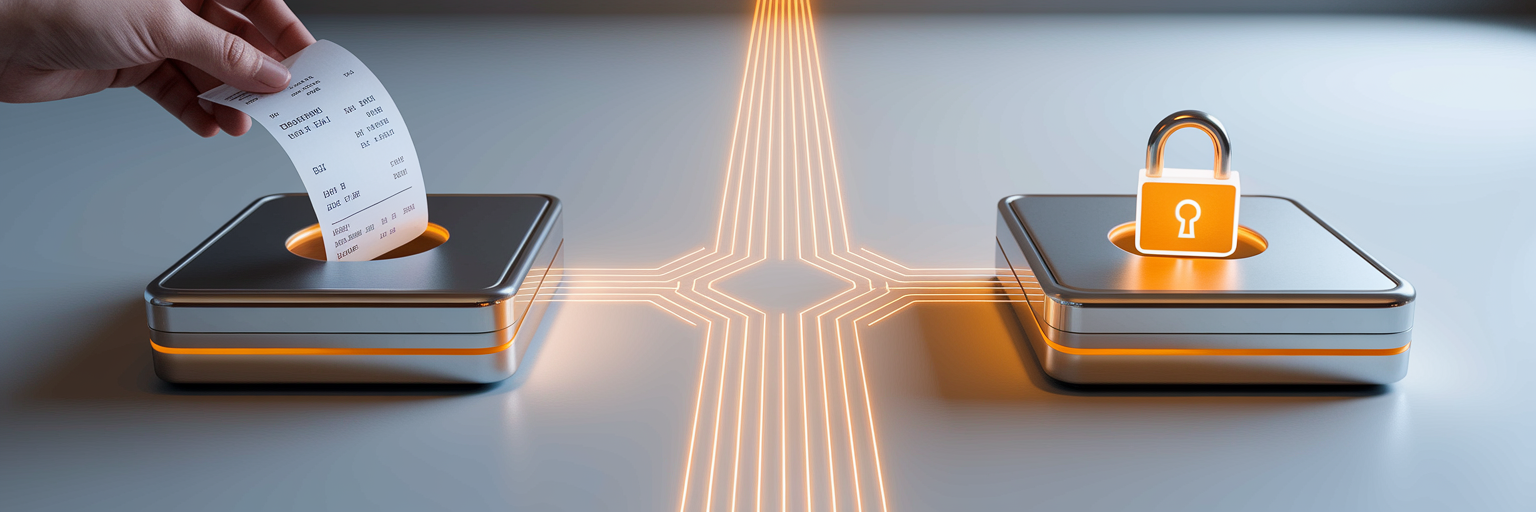Securing Financial Data with Encrypted Receipt Uploads

The Foundation of Privacy-First Receipt Handling
In an era where a single data breach can dissolve years of customer trust, data security has shifted from a reactive measure to a core design principle. Privacy can no longer be an afterthought. For accounting, a privacy-first approach means data protection is woven into a system’s architecture from its very inception. This stands in stark contrast to traditional models that often add security features later, much like adding a bigger lock to a flimsy wooden door instead of building a vault with reinforced walls from the start.
The risks of handling unsecured financial data are tangible and severe. They extend beyond regulatory fines to include lasting reputational damage and a direct loss of clients who expect their sensitive information to be protected. We have all heard stories of businesses that failed to recover after their data was compromised, a clear warning for anyone handling financial records.
The cornerstone of any modern, secure system is end-to-end encryption (E2EE) for financial data. With E2EE, receipt information is rendered unreadable the moment it leaves a user’s device and remains that way until it is accessed by an authorized party. This process makes the data useless to any intermediary or attacker who might intercept it. Adopting these secure receipt upload methods is not just a technical upgrade. It is a fundamental business strategy for building sustainable trust in a data-sensitive world.
Core Encryption Protocols and Key Management
With the importance of a privacy-first mindset established, we can explore the specific technologies that make it possible. The conversation moves from the ‘why’ to the technical ‘how’. Industry-standard protocols for encryption are the bedrock of this security structure. As highlighted in a 2025 guide from Training Camp, security experts widely recognize AES-256 and RSA-4096 as leading protocols for robust data protection.
These two protocols serve distinct but complementary roles. Think of RSA-4096 as the secure, armored vehicle that transports your data, creating a protected tunnel for it to travel through. Meanwhile, AES-256 is the impenetrable safe where the data is stored once it reaches its destination. In a practical receipt upload workflow, a user scans a receipt, and the app encrypts it on their device using a public key (RSA). The encrypted file is then sent to the server, where it is stored securely (encrypted with AES). Only the authorized user, holding the corresponding private key, can decrypt and view it.
Of course, encryption is only as strong as the keys that lock and unlock the data. This brings us to cryptographic key management. The best practice involves using Hardware Security Modules (HSMs), which are specialized, tamper-resistant devices designed to generate and protect these keys from software-based attacks. It is important to acknowledge the inherent trade-off here. Absolute security can sometimes come at the cost of user accessibility, a balance that every system must carefully manage.
| Component | Role in Receipt Security | Industry Standard |
|---|---|---|
| Asymmetric Encryption | Secures the data transfer channel between the user’s device and the server. | RSA-4096 |
| Symmetric Encryption | Encrypts the actual receipt file for secure storage (at rest). | AES-256 |
| Cryptographic Key Management | Generates, stores, and manages the keys used for encryption and decryption. | Hardware Security Modules (HSMs) |
| Hashing Algorithm | Creates a unique, fixed-size fingerprint of the data to verify its integrity. | SHA-256 or SHA-3 |
Implementing Zero-Knowledge and Zero-Trust Models
Building upon standard encryption, advanced security paradigms offer even greater protection. These models represent the next step in creating truly private financial systems, moving beyond just securing data to fundamentally rethinking how it is accessed and verified.
Verifying Data with Zero-Knowledge Proofs
Zero-knowledge proofs (ZKPs) are a fascinating concept. They provide a method to prove a statement is true without revealing the underlying data that supports it. How does this apply to privacy-first accounting software? Imagine an auditor needing to confirm that a company’s total expenses match the sum of 1,000 encrypted receipts. With ZKPs, the auditor can perform this verification without ever decrypting or viewing the contents of a single receipt. This capability is a core component of true zero-knowledge accounting protocols, ensuring privacy even during necessary validation processes.
Securing Access with a Zero-Trust Architecture
Complementing zero-knowledge is the ‘zero-trust’ model, which operates on the simple but powerful mantra: ‘never trust, always verify.’ This architecture discards the outdated idea of a trusted internal network where users inside the firewall are assumed to be safe. Instead, it demands strict identity verification for every user and device attempting to access any resource, regardless of their location. It is like having a security checkpoint at every door inside a building, not just at the main entrance.
These two models work together beautifully. Zero-trust secures the perimeter and all access points, ensuring only authenticated users get through. At the same time, zero-knowledge protects the data’s privacy even when it needs to be used for verification. For businesses seeking to implement these advanced frameworks, platforms like Zerocrat are pioneering this approach to financial data management, offering a glimpse into the future of secure accounting.
Integrating Secure Automation and Access Controls
While robust encryption forms the foundation, the operational layer is where security meets daily usability. Features like automated data extraction and user access must be implemented without creating vulnerabilities. For instance, many accounting tools use AI and Optical Character Recognition (OCR) to pull information from receipts. In a privacy-first model, this process cannot expose raw data. The solution is to perform this extraction on the user’s device before the data is ever encrypted and sent to a server.
The choice of cloud infrastructure is equally important. When selecting a cloud partner, you must verify their commitment to security. Look for providers that offer data residency options, transparent security policies, and a proven track record of protecting sensitive information. Once the data is stored, controlling who can access it is paramount. This is where Role-Based Access Controls (RBAC) become essential. A well-designed RBAC system ensures an employee can only upload their own receipts, a manager can only approve receipts for their team, and an accountant sees only aggregated data for reporting. It enforces a principle of least privilege, limiting access to only what is necessary.
Finally, certain security measures are simply non-negotiable. To achieve effective encrypted receipt management, every system must follow these core principles:
- On-Device Processing: Ensure AI and OCR data extraction happens locally on the user’s device to prevent unencrypted data from ever reaching the server.
- Granular Access Controls: Implement Role-Based Access Controls (RBAC) to enforce the principle of least privilege, ensuring users can only access data essential to their function.
- Mandatory Multi-Factor Authentication (MFA): Require MFA for all users to add a critical layer of verification that protects against credential theft.
Ensuring Ongoing Compliance and System Integrity
Implementing a secure system is just the beginning. The real work lies in maintaining its integrity over the long term. Data privacy regulations like GDPR are constantly changing, and chasing compliance for each new law is an inefficient strategy. Instead, systems should be built on timeless privacy principles. By embracing data minimization, which means only collecting what is absolutely necessary, and purpose limitation, which restricts data use to its stated purpose, you can create inherently adaptable and GDPR compliant accounting systems by design.
Security is a continuous process, not a one-time setup. It requires ongoing vigilance. Regular vulnerability scanning, periodic security audits, and constant monitoring are essential to verify that encryption protocols remain intact and access policies are being enforced. Think of it as the routine maintenance that keeps a high-security vault impenetrable year after year.
Ultimately, a privacy-first strategy aims to create a self-strengthening security posture where robust technology, transparent policies, and proactive monitoring work in concert. This comprehensive approach not only protects data from external threats but also builds and preserves the most valuable asset of all: enduring user trust.


